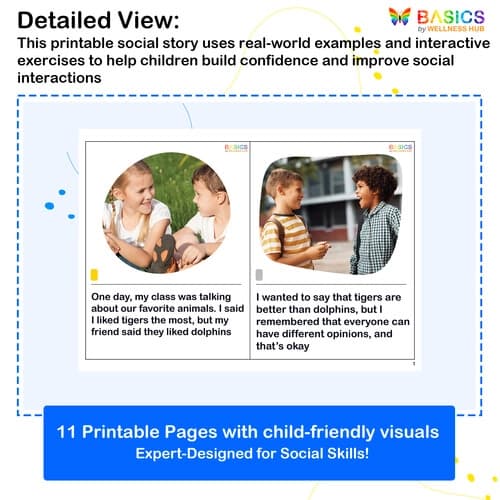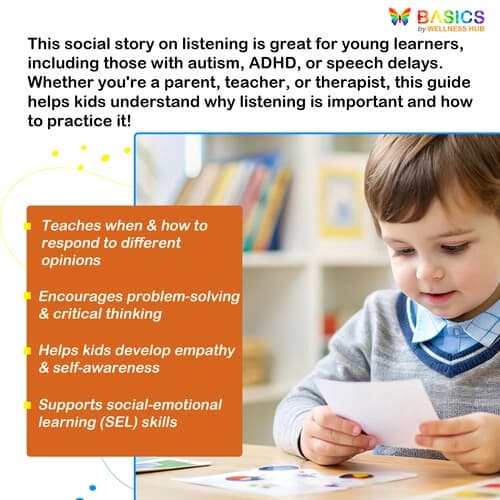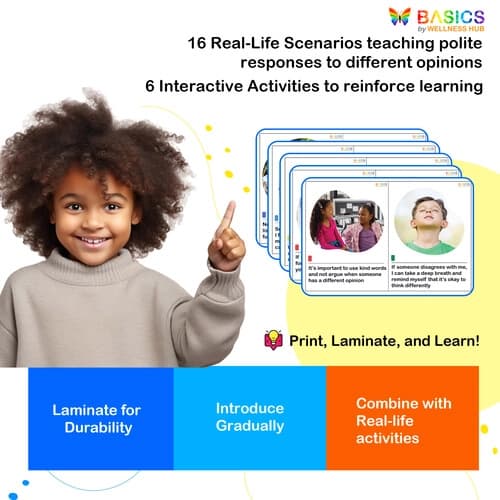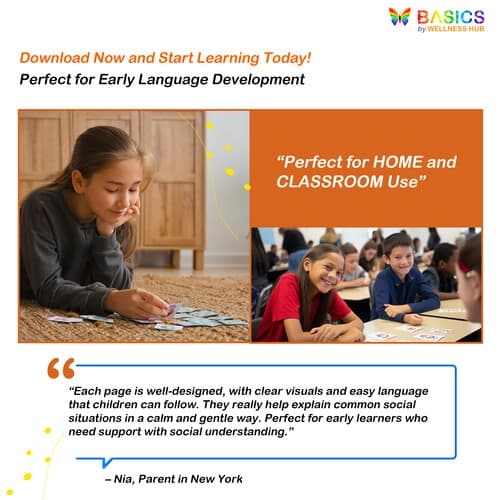



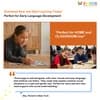

Respecting Others’ Opinions – Free Social Story for Kids
₹80
₹160
50% off
0 (0 ratings)
Grade Levels
Pre-K - Grade 3 (Ages 4-9)
Content Overview
Format: Free Printable PDF, Total Pages: 11, Features (≤15 words): 16 real-life scenarios, engaging illustrations, interactive activities, simple and clear storytelling
Categories
Pages from the Resource
Teach kids the importance of respecting different opinions with this free printable social story. Through real-life scenarios and engaging activities, children will learn to listen, understand, and respond politely when others have different views. Ideal for kids with autism, ADHD, and social-emotional challenges.
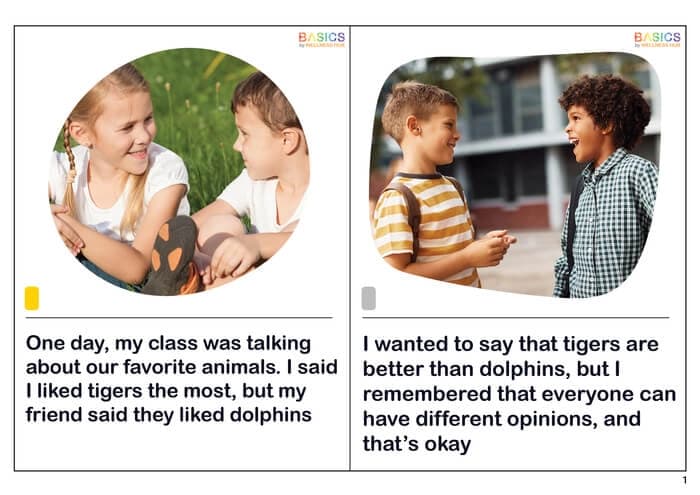
Page 1

Page 2
What Users Say
0
0 ratings
5
0+
4
0+
3
0+
2
0+
1
0+
5 Stars
Product is Good to use.
1 year ago
Varsha Parent
Similar Products
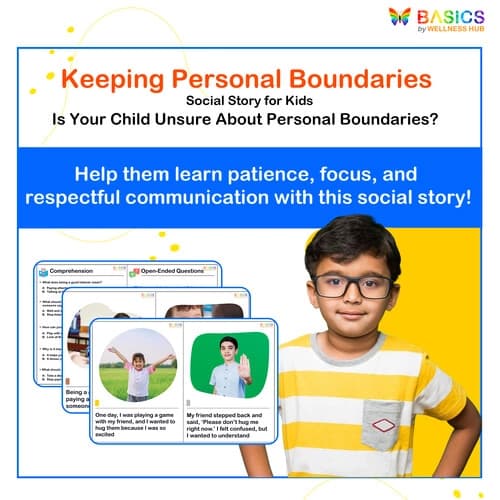
Keeping Personal Boundaries – Free Social Story for Kids’ Personal Space
FREE
₹160
50% off
5.0 (58 ratings)
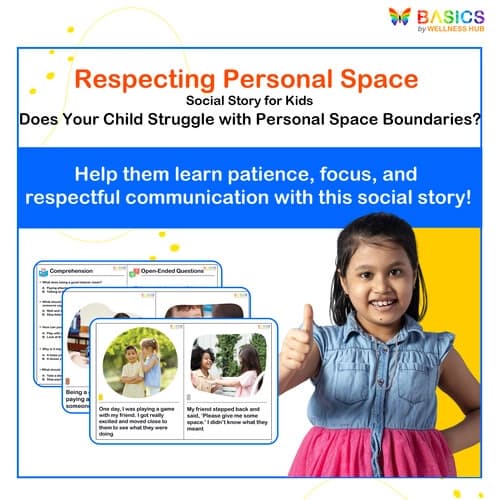
Respecting Personal Space – Social Story for Kids’ Personal Boundaries
₹ 80.00
₹ 160.00
50% off
4.9 (54 ratings)

Inviting Someone to Play – Social Story for Kids’ Social Skills
₹ 80.00
₹ 160.00
50% off
4.8 (50 ratings)
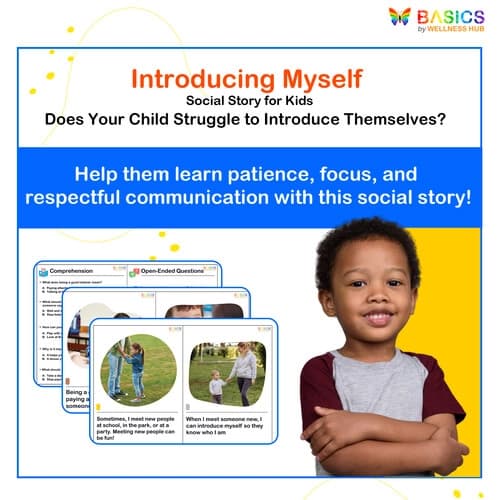
Introducing Myself – Free Social Story for Kids’ Communication Skills
₹ 80.00
₹ 160.00
50% off
4.8 (60 ratings)

What to Do When I Want to Shout – Free Social Story for Self-Regulation
FREE
₹160
50% off
4.7 (58 ratings)
About the Product
Introduction
Children often struggle to understand that everyone has different thoughts, beliefs, and opinions. Whether discussing favorite colors, choosing a game to play, or having different perspectives on school subjects, disagreements can sometimes lead to frustration, arguments, or hurt feelings.
Some kids may:
✔ Interrupt or dismiss someone else’s opinion.
✔ Struggle with sharing their own opinion politely.
✔ Feel upset when others don’t agree with them.
✔ React emotionally rather than listening and understanding.
This free printable social story teaches children how to:
✔ Listen respectfully to different opinions.
✔ Express their own viewpoints calmly and kindly.
✔ Respond positively when someone disagrees.
✔ Understand that it’s okay to have different ideas.
By learning these skills, children will feel more confident, open-minded, and socially adaptable, helping them build stronger friendships and relationships.
Product Details
- Format: Free Printable PDF
- Total Pages: 11
- Number of Segments: 16 real-life social scenarios
- Features:
✔ Simple, engaging language for young learners
✔ Colorful illustrations to reinforce social concepts
✔ Interactive activities to practice respecting opinions
✔ Designed for home, school, and therapy use
This resource is printable and digital-friendly, meaning it can be used on tablets, computers, or printed as a physical book.
Educational Benefits
1. Helps Kids Understand Different Perspectives
- Encourages children to recognize and appreciate others' viewpoints.
- Reinforces that everyone thinks differently, and that’s okay.
2. Teaches Polite Communication Skills
- Provides structured examples of how to respond to disagreements respectfully.
- Helps kids practice active listening and positive social interactions.
3. Builds Social-Emotional Learning (SEL) Skills
- Supports self-regulation when facing differing opinions.
- Encourages critical thinking and emotional intelligence.
4. Supports Children with Autism & Social Challenges
- Uses clear, structured storytelling to help kids on the autism spectrum or with ADHD.
- Reinforces expected social behaviors in a variety of real-life scenarios.
5. Prepares Kids for Classroom & Peer Interactions
- Teaches kids how to collaborate, compromise, and respect different viewpoints in group settings.
- Helps children develop confidence when expressing their own ideas while respecting others.
Instructions for Use
Step 1: Read the Social Story Together
- Read the story out loud with your child or student.
- Pause on each scenario and ask questions like:
- “What would you do if a friend had a different favorite food than you?”
- “How can we respond when we disagree with someone’s opinion?”
Step 2: Discuss the Scenarios
- Relate the story to real-life experiences by discussing past disagreements.
- Ask the child to explain how they feel when others disagree with them.
- Emphasize that listening and understanding are important even if we don’t agree.
Step 3: Engage in Role-Playing
- Act out different scenarios from the social story and practice responses.
- Encourage the child to:
✔ Listen first before speaking.
✔ Use respectful phrases like “That’s an interesting idea!” or “I see your point.”
✔ Stay calm and polite, even if they feel frustrated.
Step 4: Complete Interactive Activities
- The story includes fun exercises to reinforce key concepts, such as:
✔ Sorting polite vs. impolite responses to different opinions.
✔ Matching situations with the best way to respond.
✔ Drawing or writing their own examples of respecting different viewpoints.
Step 5: Reinforce the Lessons in Real-Life Situations
- Encourage children to apply what they’ve learned when talking to friends, family, and teachers.
- Provide gentle reminders if they react negatively to a different opinion.
- Praise and reinforce positive behaviors when they show respect and understanding.
Activities Using the Resource
1. "Agree or Disagree?" Sorting Game
Objective: Teach children that different opinions are okay and how to respond to disagreements respectfully.
Materials: Printable sorting cards (optional) or verbal prompts.
How to Play:
- Create two categories: "Agree" and "Disagree."
- Read aloud different opinion-based statements, such as:
- "Chocolate is the best ice cream flavor!"
- "Cats make better pets than dogs."
- "Video games are better than board games!"
- Ask the child to decide whether they agree or disagree and place the statement in the correct category.
- Discuss how to respond politely when someone has a different opinion.
- Example: Instead of saying, “That’s wrong!” say, “I like board games more, but I see why you like video games.”
2. "How Would You Respond?" Role-Playing Game
Objective: Help children practice polite communication skills when facing different opinions.
Materials: None (or printed conversation cards if available).
How to Play:
- One person states an opinion, such as:
- “I think pizza is the best food ever!”
- The other person responds in different ways (rude, dismissive, polite).
- The child must identify which response is the best and explain why.
- Encourage responses that show respectful disagreement, such as:
- “I like pasta more, but pizza is really good too!”
- “That’s an interesting opinion! I prefer burgers.”
3. "Can We Find Common Ground?" Discussion Activity
Objective: Teach children how to find something in common even when they disagree.
Materials: A list of opinion-based questions.
How to Play:
- Ask the child questions like:
- "What’s your favorite color?"
- "What’s the best kind of dessert?"
- "Who is the best superhero?"
- If you and the child disagree, encourage them to find a common connection.
- Example:
- Child: "I love chocolate ice cream!"
- Parent: "I like vanilla more."
- Common Ground Response: "But we both like ice cream!"
- Example:
- Reinforce the idea that differences are okay, and we can still connect with others.
4. Draw & Reflect – "Respecting Opinions in Real Life"
Objective: Encourage children to apply what they learned in personal situations.
Materials: Paper and crayons.
How to Play:
- Ask the child to draw a time when they disagreed with someone.
- Encourage them to illustrate how they handled it.
- If they responded negatively, discuss how they could respond better next time.
- Praise good examples of respectful disagreement!
FAQs
Q1: Who is this social story designed for?
A1: This resource is ideal for children ages 4–9 who need support in learning how to respect different opinions. It is especially helpful for children with autism, ADHD, speech delays, and social-emotional learning needs.
Q2: How can I use this story at home?
A2: ✔ Read the story out loud with your child and discuss the examples.
✔ Ask questions like, “Has this ever happened to you?”
✔ Role-play disagreements and practice polite responses together.
✔ Reinforce positive behavior when your child respects different opinions in real life.
Q3: Can this social story be used in classrooms?
A3: Yes! Teachers can:
✔ Read it during social-emotional learning (SEL) lessons.
✔ Use it before class discussions to reinforce respectful communication.
✔ Assign group activities to encourage active listening and respectful dialogue.
Q4: What if my child struggles with handling disagreements?
A4: ✔ Be patient and provide consistent reinforcement.
✔ Use real-life examples to show how different opinions can exist peacefully.
✔ Model respectful disagreement in your own conversations.
✔ Encourage small steps, like pausing before reacting negatively.
Q5: Can this story help children with social anxiety?
A5: Yes! This social story provides structured guidance to help children feel confident in expressing their opinions while being respectful of others. It helps them navigate social interactions with less anxiety.
Usage Rights and Restrictions
Allowed Usage:
- Personal use by parents, teachers, and therapists.
- Printable for classroom, home, or therapy use.
- Can be used in group or one-on-one learning sessions.
Not Allowed:
- Reselling, redistributing, or modifying the resource for commercial use.
- Sharing publicly (e.g., blogs, social media, or websites) without permission.
- Uploading the file to public sharing platforms.
If you need a bulk license for schools or therapy centers, please contact us.
Conclusion
Teaching children to respect different opinions is an essential part of developing empathy, kindness, and social intelligence.
This social story provides a structured and engaging way for children to:
✔ Understand that everyone has different thoughts and ideas.
✔ Learn how to listen before responding.
✔ Practice respectful ways to agree or disagree.
✔ Gain confidence in expressing their own opinions.
By reinforcing these skills through daily practice, role-play, and fun activities, children will develop lifelong habits that improve their relationships and emotional well-being.
With patience and practice, respecting different opinions will become second nature!
